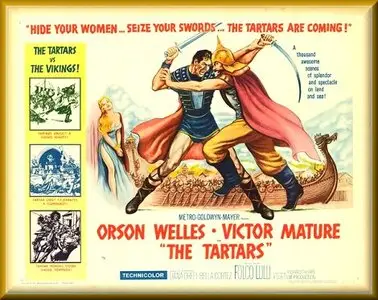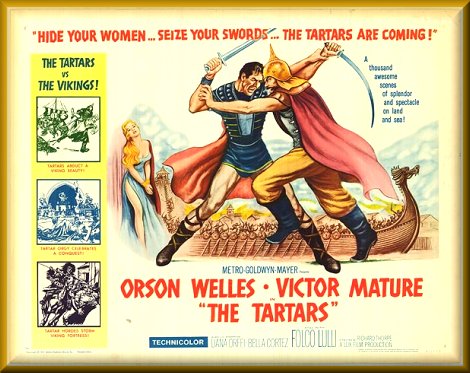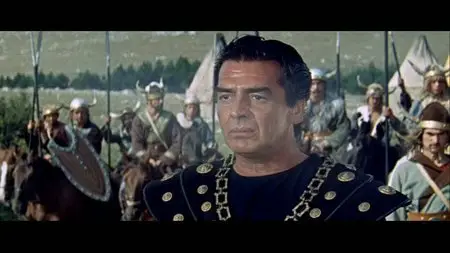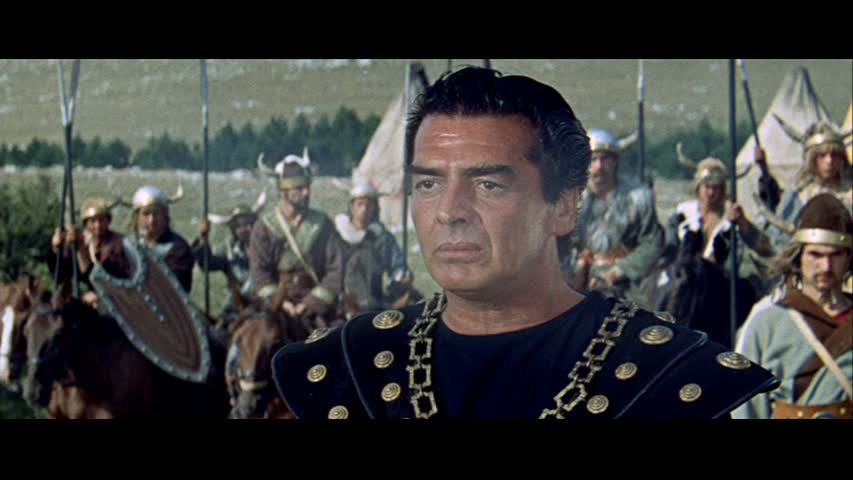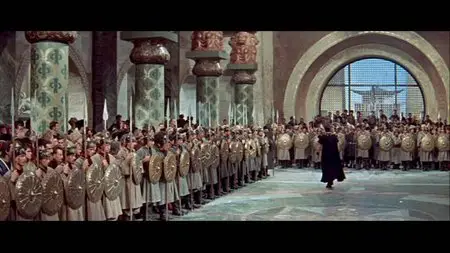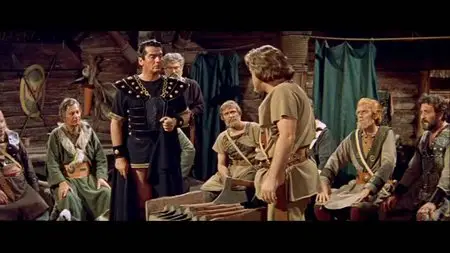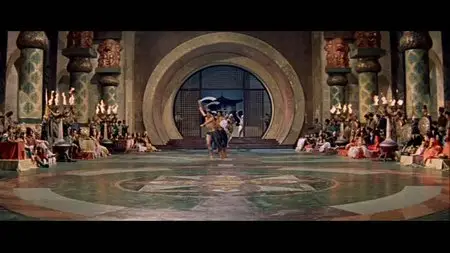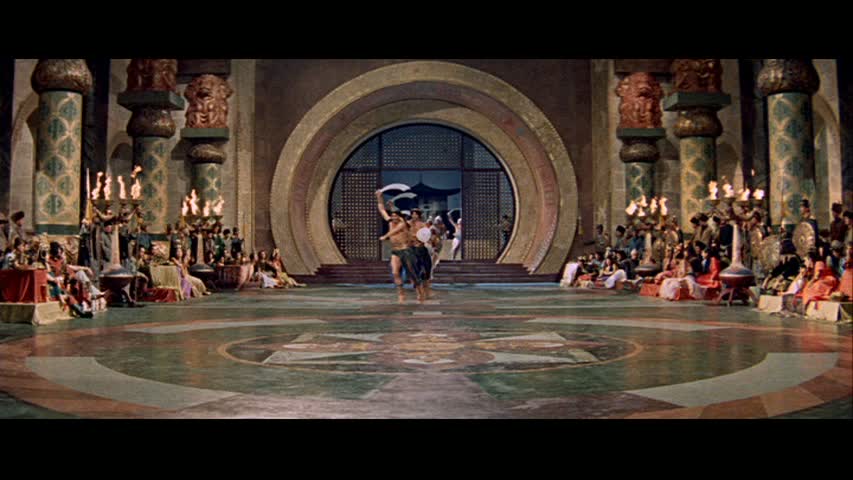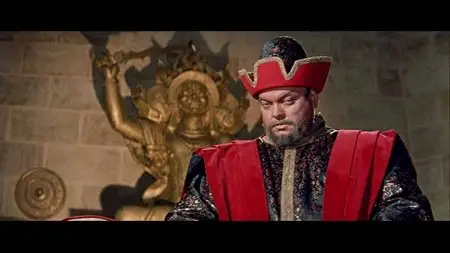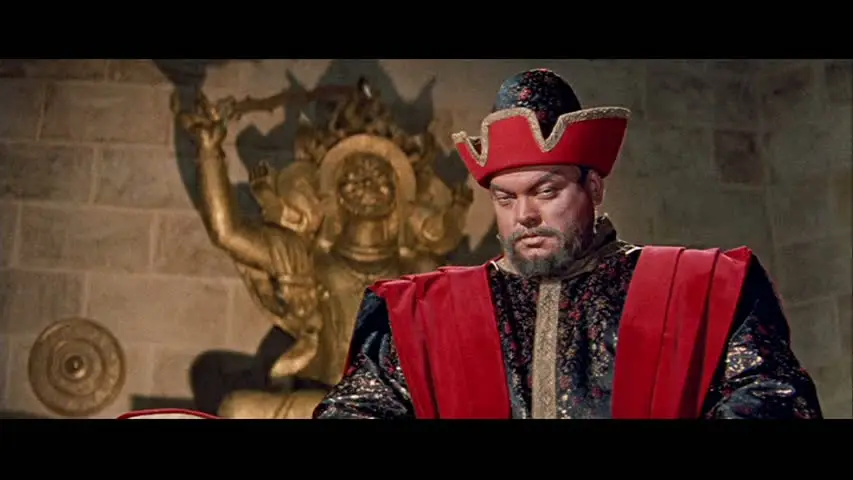The Tartars / I tartari (1961)
DVD5 |VIDEO_TS | NTSC | 16:9 | 720x480 | 6600kbps | 4.2Gb
Audio: English AC3 2.0 @ 192 Kbps
01:23:00 | Italy, Yugoslavia | Action, Adventure, Drama
DVD5 |VIDEO_TS | NTSC | 16:9 | 720x480 | 6600kbps | 4.2Gb
Audio: English AC3 2.0 @ 192 Kbps
01:23:00 | Italy, Yugoslavia | Action, Adventure, Drama
A barbarian army attacks Viking settlements along the Russian steppes.
Directors: Richard Thorpe, Ferdinando Baldi
Cast: Victor Mature, Orson Welles, Liana Orfei, Arnoldo Foa, Luciano Marin, Bella Cortez, Furio Meniconi, Pietro Ceccarelli, Renato Terra, Folco Lulli, Spartaco Nale
Warner Bros. Sjop
Blood will beget blood. Viking chief Oleg (Victor Mature) slays a leader of the Russian Tartars and takes a lovely Tartar maid captive. Tartar overlord Burundai (Orson Welles) retaliates, making Oleg's wife his hostage. The fuse of conflict has been lit. Bad blood between the two medieval realms will seethe and explode into all-out war. One of the most unusual of the many Italian-made spectacles to roll across American movie screens in the early 1960s is also one of the most thunderously action-filled. Versatile filmmaker Richard Thorpe, who a decade earlier guided the power and pomp of Ivanhoe and The Prisoner of Zenda , here stages eye-catching production pieces that include a libidinous night of pageantry and revelry at Burundai's court, the tumultuous sweep and clash of horse-mounted armies across the Russian steppes and the savage sword-to-axe siege of a blazing Viking fort. The pages of history turn red in The Tartars.
"Hordes storm fortress!" "Tartars Abduct Viking beauty!" "Orgy celebrates conquest!" These were some of the tag lines used to promote the period epic The Tartars (1961), one of many European imports that reached American shores during a brief "sword and sandal" craze in the late fifties/early sixties. Hercules , the 1959 peplum sensation starring Steve Reeves, started it all. Producer Dino De Laurentiis bought the rights and distributed it in the U.S. in 1959, transforming it into a huge box office hit. After that, every major studio was scrambling to duplicate that success and MGM was no exception, importing such muscle-bound contenders as The Giant of Marathon (1960), Morgan the Pirate (1961) and The Son of Spartacus (aka The Slave , 1963) - all of them starring Steve Reeves. The Tartars, however, had a different pedigree and a more distinctive one. Not only was it helmed by Richard Thorpe, one of MGM's most dependable directors of costume epics (Ivanhoe (1952), The Prisoner of Zenda (1952), Knights of the Round Table , 1953), but it sported two high profile marquee names - Victor Mature and Orson Welles.
Set in medieval Russia, the film quickly establishes a growing animosity between two neighboring clans, the Tartars and the Vikings. The Tartars, driven by a desire to conquer and control the region, force the Vikings into a bloody confrontation that ends up with both tribes taking a female hostage from their rival. Oleg (Victor Mature) is forced to deal directly with Tartar chief Burundai (Orson Welles) who has imprisoned his wife Helga (Liana Orfei), while the Vikings place the beautiful Samia (Bella Cortez) in high security confinement. The difference between the two camps is demonstrated by how they treat their respective "guests." Helga is drugged, ravaged by Burundai and then tossed to his soldiers for a gang rape; Samia is treated with respect and soon falls in love with her captor Eric (Luciano Marin), the son of Oleg. The end result? A climactic battle on the banks of the Volga River with the Viking village in flames and a mounting death toll on both sides.
It must be said that The Tartars is not Orson Welles's finest hour. Dressed in outre barbarian garb and looking like a larger than life helium-filled balloon character, he delivers his often risible dialogue fearlessly: "When I have conquered the West the world will be at my feet and then my wrath will be very terrible." Images of Elmer Fudd singing "kill the wabbit" from What's Opera, Doc? immediately spring to mind. Welles is not much of an action figure either and spends most of the film seated on his throne, glaring at his court. Victor Mature isn't any threat to Steve Reeves either and looks clearly uncomfortable in his toga and sandals costume. He does, however, throw a mean axe and gets to mug outrageously in his big death scene. Whoops. Guess it's too late to post a spoiler alert.
Obviously it wasn't the script that attracted both Welles and Mature to The Tartars. Welles spent a large part of his career taking acting jobs to help finance his own productions and this one was no exception. He was still in the midst of completing his screen version of The Trial , based on the Franz Kafka novel, which would be released in 1962. Mature, on the other hand, was at the end of his Hollywood career and needed the money. In fact, after The Tartars, he would not make another movie until 1966 when he parodied his own screen image in After the Fox , a Peter Sellers comedy that poked fun at the Italian film industry.
What most people don't know is that the on-screen rivalry of Welles and Mature in The Tartars also continued off-screen and on the set. The two men shared an intense dislike for each other ever since a long ago romantic competition over Rita Hayworth (who married Welles). In an interview with Peter Bogdanovich for the book, This is Orson Welles , the actor recalled making The Tartars: "It was a perfectly legible drive-in kind of movie…Victor Mature had been told - incorrectly - by the costume department that I had built up my shoes by two inches to make myself look taller. So he went and got his sandals built three inches high and he could hardly walk. Very funny sandals, too - you look like a brassiered carioca girl in a carnival. And he could barely get across the stage in those things - just so he would be taller than I was, you see, neglecting to look at the script and see that in all our scenes I am sitting on the throne! His whole exercise in who was going to be the highest was a terrible waste of time. And when he came to have the sword fight, his double was definitely shorter than I was…"
According to most reports, Victor Mature was indeed the chief troublemaker on The Tartars set, throwing numerous "I'm-a-big-star" tantrums. In one incident cited in the biography Orson Welles by Barbara Leaming, production assistant Alessandro Tasca (a descendant of Sicilian aristocrat Alexander Pocket of Cuto) rushed "to find Mature engaged in a furious dispute with director Richard Thorpe. "You son of a bitch!" Mature was heard to address the gentlemanly director. "What's wrong, Mr. Mature?" interjected the prince, who deliberately refrained from ever calling him Victor. "You're a son of a bitch too!" he replied. "Well, Mr. Mature," Tasca said calmly, "maybe I am a son of a bitch, but what is this all about?" "In this scene you shot two close-ups of Orson Welles, and the son of a bitch wants to do only one close-up of me!" said Mature, "I want three close-ups!" With which request Tasca loudly advised the director to comply, while more quietly instructing the cameraman only to pretend to film the extra shots. "It was a terrible picture!" the prince wryly admits of The Tartars."
Terrible seems far too severe a rating for The Tartars, however, since the film does have its entertaining aspects. One memorable highlight is an elaborate production number staged for Burundai's amusement where a troupe of bare-chested men do a saber dance, complete with Las Vegas style high kicks and cartwheels, that culminates with a male and female dancer wrestling and rolling across the marble floor in some Tartar version of the "Apache" dance. The action sequences - and there are plenty of them - are well staged and include a somewhat suggestive battering ram attack and such audience-pleasing deaths as flaming arrows in the back, spears in the neck, and boulders on the head. Even the costumes look authentic and the settings are postcard perfect - it was filmed in Italy and Yugoslavia. But what you'll remember most is the great Welles in mock Asian makeup delivering lines like "Oleg, I will destroy you" as if it were written by Shakespeare.
~ Jeff Stafford
IMDb
Burundai, comandante dei Tartari, prende il posto del fratello Togrul, ucciso durante la battaglia contro gli Slavi, a causa del rifiuto del comandante vichingo Oleg di unirsi a loro. Dopo l'assassinio della piccola figlia di Togrul per mano dei Vichinghi e della moglie di Oleg per mano dei Tartari, i due capi si affrontano in battaglia. Written by rosebud6
Orson Welles is tartar leader Burundai, who takes the place of his brother Togrul, killed during the battle against the Slavs, as Viking chieftain Oleg refuses to join him. After the kidnapping of Togrul's daughter by the Vikings, and Oleg's wife, by the Tartars, the two leaders have a fight…
~ Adalberto Fornario


